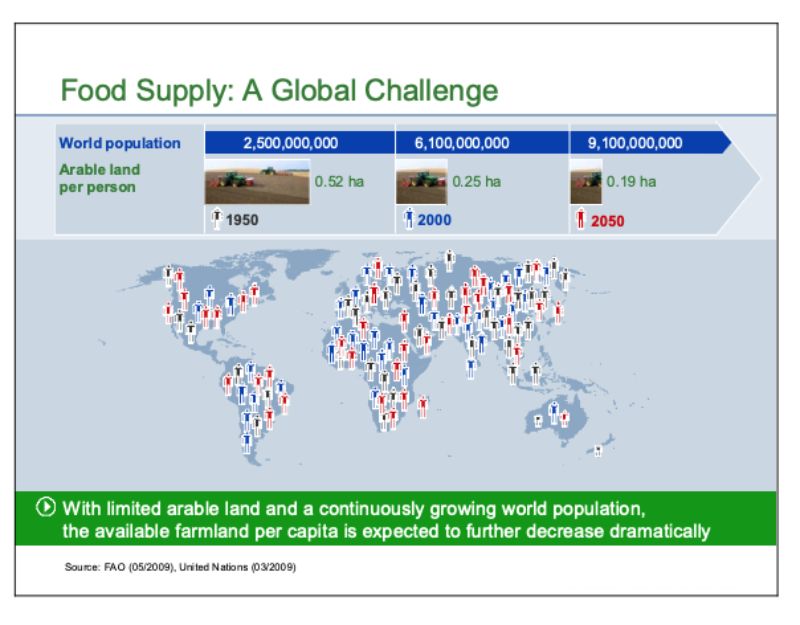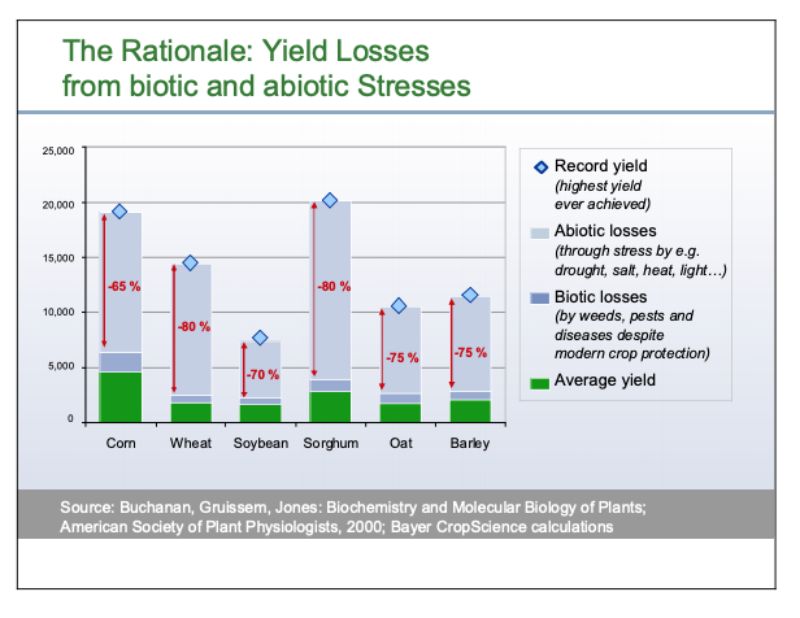Summary
Limited arable land, climate change and a continually growing world population are posing major
challenges for agriculture. It is vital to safeguard, and even boost, yields of agricultural raw materials.
Bayer CropScience has one of the largest research budgets in the industry, at around EUR 650 million
annually, and will be maintaining its innovative emphasis on novel crop protection products with new
modes of action which can help to safeguard yields, produce high-quality crops and manage resources
efficiently, in the interests of the environment. We are convinced that we need to increase our focus
on modern plant breeding in the development of new and high-yielding hybrid varieties and make
greater use of the opportunities offered by plant biotechnology.
Scientific progress has made a crucial contribution to enabling agricultural yields to be increased substantially. The challenges facing the world require us, once again, to reinforce our commitment to agricultural science, research and application-oriented innovations. Society has a responsibility to show its solidarity by searching for ways of safeguarding the world’s food supply. What we need, therefore, is a new initiative to drive agricultural innovation – in other words a “second green revolution” – that will extend the precious potential of our crops to meet needs while preserving the environment.
Scientific progress has made a crucial contribution to enabling agricultural yields to be increased substantially. The challenges facing the world require us, once again, to reinforce our commitment to agricultural science, research and application-oriented innovations. Society has a responsibility to show its solidarity by searching for ways of safeguarding the world’s food supply. What we need, therefore, is a new initiative to drive agricultural innovation – in other words a “second green revolution” – that will extend the precious potential of our crops to meet needs while preserving the environment.
Introduction
The sustained growth of the world’s population and the economic development of emerging countries are combining to create a growing demand for agricultural products. The demand for renewable raw materials to provide energy and fuel is also increasing. However, the amount of arable land available is limited and subject to rising urban sprawl and soil degradation. Moreover, water shortage is endangering agriculture more and more, particularly in the southern hemisphere. Together these complex factors are creating some major challenges for a multifunctional and sustainable agriculture.There are more and more of us
Although population growth is slowing, there will probably, according to the United Nations World Population Prospects, still be more than nine billion people living on our planet in 2050. Most of this growth will take place in what are currently developing countries. This is where more than 80 percent of all the people on Earth live and it is where an inadequate food supply is a common occurrence. Around a billion people currently do not have enough to eat. The population in sub-Saharan Africa and Asia is especially affected by hunger, with a particular focus within Asia on India and China. An additional trend is emerging. The proportion of people who live in an urban setting is increasing worldwide. The figure is expected to grow to around 60 percent by 2030. In Latin America, the urban population already outnumbers the rural population. However, some 80 percent of the undernourished people live outside the cities. Half of the hungry people live in households dependent on small-scale farming.Agriculture needs to respond in many ways
Of the approximately 13 billion hectares of land on our planet, some 1.6 billion are used for agriculture and a further 3.5 billion as meadowland and pasture. There is hardly any potential left for expanding the growing areas for wheat, rice or millet. In many parts of Asia, every last hill which can possibly be used has already been covered with rice terraces and fields. In addition, some areas of the world that are suitable for crops are being threatened by soil degradation or loss, e.g. as a result of salination or erosion. Every year, around 10 million hectares of arable land are lost to erosion worldwide and further agricultural land is endangered by salination, desertification and urban development.Increasing urbanization is additionally boosting the amount of land required for settlement and infrastructure. Additionally, political objectives designed to reduce greenhouse gas emissions are driving the use of renewable agricultural raw materials for energy generation, e.g. in order to provide fuel for the transport sector. These factors combine to create far-reaching challenges for agriculture, which consequently needs to satisfy economic, ecological and social criteria. Overall, there is no doubt that the provision of adequate food for a growing number of people is one of the most urgent imperatives of our time.
Securing the food supply is a global task
Even today, if we didn’t use modern crop protection measures and fertilizers, we would need more arable land to feed the world. A continually growing population and changing consumption habits mean that agricultural production needs to be boosted substantially. For example, per capita calorie consumption in developing countries and emerging economies continues to rise in response to increasing incomes, if nothing else, and is approaching the level in industrialized countries. China illustrates this development very clearly. Meat consumption in this country has roughly doubled in the past 15 years. This increase is associated with a growing demand for animal protein and in turn with the need to use a growing proportion of the world’s cereal harvest as animal feed. In simplified terms we can say that it takes 7 kg of cereal to produce 1 kg of beef. This differential also increases the pressure on the demand side.
According to prognoses, agricultural production must more or less double by 2050 if it is to meet the future demands for food and feed. However, there will be almost no scope for increasing the amount of land available for agricultural purposes overall in the world. This confers particular importance on agricultural production in the industrialized countries too. Although agricultural production here has already reached a high level, the industrialized countries still have a special responsibility to help in securing the world’s food supply. The World Bank, for example, expects Africa and Asia to be importing over 250 million tons of cereals in 2030. Going on present trends, most of this requirement will have to be met by exports from the industrialized countries.
Extreme weather phenomena threaten harvests
Meteorologists all over the world are recording more and more frequent extreme weather events such as absence or displacement of tropical rainfall as well as abnormal ocean current phenomena. One well-known example is El Niño. Every three to six years, torrential rains devastate whole tracts of land in South America, while at the same time extreme weather leads to droughts in South-East Africa, Indonesia and Australia and frost in Florida – and consequently to enormous harvest losses for framers. But it is not only natural disasters that cause billions of dollars worth of agricultural damage every year. Persistently unfavorable farming conditions such as water shortages, increasing salination of arable land and extreme heat and cold are prime causes of huge harvest losses. Corn, rice and wheat, for example, can no longer cope with these extreme environmental factors. The impact of extreme weather conditions can be severe: even with the best of care for their fields, farmers regularly lose between 30 and 80 percent of their harvest around the world.Although the impact of global warming as a result of climate change varies on a regional basis, it is assumed that it will have a globally negative effect on agricultural productivity. Experts expect the yield potential of crops to decrease even if local mean temperatures increase by only 1 to 2°C, particularly in seasonally dry regions and the tropics. According the World Bank, it is very likely that effects of climate change will increase the number of people at risk of hunger. Water plays a key role here, and it has been designated as one of the most limited natural resources of this century.
Efficiency is a basis for sustainable agricultural production
The need to provide a growing number of people with sufficient, high-quality, affordable food is one of the biggest challenges facing the agriculture of the future. The prices of agricultural products declined substantially during the 20th century, only to rebound strongly, particularly in 2008. This was the result of many factors, among them increased demand, higher production and transport costs, diminished inventories, climate-related harvest failures, trade restrictions as well as the fact that agricultural markets became the focus of the financial markets. In spite of the recent price decreases in 2009, the Organization for Economic Development and Cooperation (OECD), for example, expect prices for agricultural raw materials to remain at a considerably higher level in the longer term than they were a few years ago. The complex interplay of factors and the many and varied requirements that agricultural production needs to satisfy, make efficient use of natural resources, e.g. water, soil and nutrients such as nitrogen, absolutely vital. At the same time, the high quality of harvests needs to be ensured. It is, therefore, important to ensure that high-quality crops can be grown on the limited land available and to increase yields wherever possible. The higher the yield per hectare of cultivated land, the greater the opportunities for achieving a balance between agricultural and natural land.
Not using crop protection, limits efficient use of resources
Crop protection products help to secure yields by protecting crops against harmful organisms. The effect of harmful factors on yields has been investigated in several studies. Studies at the Institute for Plant Diseases at University of Bonn, Germany, for example, indicate that weeds, fungal diseases and insects together account for the loss of 42 percent of harvests of the world’s eight most important crops: rice, wheat, barley, corn, potatoes, soybeans, cotton and coffee. If no crop protection products at all were used, up to 70 percent of these crops would be lost. Scientists did observe some major fluctuations. Rice, for example, has the genetic capacity to produce up to 20 tons of grains per hectare. Real yields, however, vary between just one and 11 tons. These lower yields are the result of environmental stress factors mentioned previously.A fungicide which helps wheat to grow
Some particular active ingredients used in crop protection products are opening up new horizons. One of them is trifloxystrobin from Bayer CropScience, an antifungal agent belonging to the strobilurin class of active ingredients which protects cereals, vegetables and fruit against harmful fungal diseases. It also increases the resistance of plants to stress. Field trials have shown that crops treated with strobilurins produce better harvests than those protected with other types of antifungal agent. Crops protected with trifloxystrobin also do much better than untreated plants under conditions of drought. The active ingredient evidently triggers a number of different beneficial effects in the plant, which result in an above-average increase in yield. Recent research has also shown that certain active ingredients – such as the one used in the insecticide Gaucho® from Bayer CropScience – can even make rice plants more resistant to fluctuations in the salt content of water.Bayer CropScience has one of the largest research budgets in the industry (some EUR 650 million annually), and will be maintaining its innovative emphasis on novel crop protection products with new modes of action which will enable farmers to achieve high yields. These not only include chemical crop protection products but also products for biological pest control such as Bacillus firmus, which can be used to protect seeds against nematodes (soil-dwelling threadworms).
Innovation is indispensable
New technologies will play a major role in making efficient use of scarce agricultural resources. In the past, scientific progress and modern crop protection enabled yields to be increased substantially and safeguarded. However, analysis of the International Food Policy Research Institute, Washington, USA makes clear, that spending on agricultural research has slowed considerably all over the world since the 1970s. The consequences are dramatic. In the 1980s, cereal yields were increasing at a rate of more than three percent annually; today, yields of wheat and rice in particular, are growing at between one and two percent. The forecast trends in demand show clearly that this is nowhere near enough. This is why agricultural research is more important today than ever before. A global agricultural initiative to drive innovation is needed, to sustainably exploit the potential of agricultural crops.Stress-tolerant plants cope considerably better with extreme climates
One of the foremost objectives of crop protection research is to increase the yields of corn, rice and wheat and to make plants more tolerant to severe heat, cold, drought or intense sunlight. These factors expose plants to enormous stress. They trigger a process that can lead to self-destruction. Energy-intensive repair processes substantially increase the plant’s energy consumption. This has dramatic consequences for the plant: It can no longer properly supply leaves, fruit or stems with energy. Individual cells gradually die, ultimately leading to the death of the plant.Researchers at Bayer CropScience are using biotechnology to equip canola plants, for example, to cope with several stress factors. They are designing a kind of fitness program for plants. Firstly, they incorporate genes into plants which should help them deal with excessive stress caused by dry and wet conditions. Secondly, they quite specifically deactivate individual genes which trigger excessive stress reactions in normal plants which result in lower yields. This should enable the plants to produce consistently high, stable yields over the longer term, despite fluctuating environmental conditions. Bayer CropScience is using classic plant breeding techniques, plant genetic engineering methods and other approaches based on modern molecular biology, such as marker-assisted breeding, in its efforts to develop high-quality seed with improved traits. In the latter, plants are selected for crossing not on the basis of their external characteristics but because of their genetic traits, which new methods allow scientists to establish beforehand. In this way, suitable partners can be selected specifically, thus accelerating the breeding process.
Plant biotechnology complements innovative crop protection
The use of biotechnology in combination with crop protection solutions in a targeted manner, can achieve significant advances in productivity. The Consultative Group on International Agricultural Research estimates that plant biotechnology alone has the potential to increase yields by around 25 percent. As a result, modern breeding methods can help to fight global hunger. The United Nations Task Force on Hunger advocates the use of plant genetic engineering in the fight against hunger. Greater resistance to environmental stress factors such as drought, salty soil, unfavorable temperatures, plant pests and diseases and an improved nutrient content are also thought to be advantageous for smallscale farmers in developing countries. Studies recently published by scientists at the Department of Agricultural Economics and Rural Development, University of Göttingen, Germany, show examples where the cultivation of plants bred using genetic engineering effects poverty reduction in some developing countries.The BioScience business unit at Bayer CropScience uses modern plant-breeding techniques to develop, among other things, high-yielding hybrid crop varieties with improved tolerance towards environmental stress factors. Our modern hybrid rice, for example, has a yield potential that is 20 to 30 % higher than that of conventional rice varieties. Its yield advantage is even greater under conditions of infection by bacterial leaf blight. When this disease hits, farmers who use our modern hybrid rice can produce up to 80 % more yield than using classical varieties.
Plant genetic engineering concerns us all
The technical application of biological processes has been used for thousands of years. For example, biotechnology has been used to modify the plant world through selection and breeding ever since mankind began to grow food. Genetic engineering methods were first applied in the early 1970s and since then the importance of biotechnology has increased continually and has become a stronger focus of public attention. Contemporaneously, plant genetic engineering has also increasingly been the subject of intense debate about risk and in some cases of emotive public discussion. From the point of view of agricultural policy, past experience with surplus agricultural production in some industrialized countries, encouraged the view that a further increase in production volumes would be undesirable.However, in view of the future challenges facing the world, industrialized countries also have a responsibility to help secure the food supply. Against this background, they have a moral obligation to enable an open and objective dialog to take place in society about the contribution that plant genetic engineering can make. Since acting ethically, also means acquiring the knowledge and awareness that will permit solutions to be found through respectful and tolerant discourse.
Agricultural policy: A fundamental element of responsible social policy
The global challenges associated with a growing world population demand an awareness of the need for solidarity and the ability and willpower to accept responsibility. Our cultural experience has taught us that efficient and sustainable agricultural production is a major fundament of our prosperity and that it is progress, not stagnation, which will help mankind to secure the future. The consideration to use modern crop protection and biotechnological products responsibly goes hand in hand with an obligation to search for ways of safeguarding the food supply and agricultural resources in the long term. Innovative agricultural policy is thus a fundamental element of a forward-looking social policy.Zusammenfassung
Herausforderungen für nachhaltige LandwirtschaftBegrenzte Anbauflächen, klimatische Veränderungen und eine weiter steigende Weltbevölkerung stellen die Landwirtschaft vor große Herausforderungen. Dabei müssen die Ernteerträge der Agrarrohstoffe sicher gestellt und sogar weiter ausgebaut werden. Bayer CropScience wird mit einem der größten Forschungsetats in seiner Branche in Höhe von rund 650 Millionen Euro auch in Zukunft seine Innovationsschwerpunkte auf neuartige Pflanzenschutzprodukte mit neuen Wirkmechanismen legen, die Erträge sichern und hochwertige Ernten sowie ein effizientes und damit umweltschonendes Ressourcenmanagement ermöglichen. Wir sind davon überzeugt, dass wir dabei die Möglichkeiten der modernen Pflanzenzüchtung mit der Entwicklung neuer Hochertrags-Hybridsorten sowie die Chancen der Pflanzenbiotechnologie verstärkt nutzen müssen.
Der wissenschaftliche Fortschritt hat maßgeblich dazu beigetragen, dass die Agrarerträge bisher beträchtlich gesteigert werden konnten. Die weltweiten Herausforderungen machen erneut ein verstärktes Engagement in Agrarwissenschaften, Forschung und anwendungsorientierte Innovationen erforderlich. Dabei steht die Gesellschaft in der solidarischen Verantwortung, nach Lösungen für eine weltweite Sicherung der Ernährung zu suchen. Wir brauchen insofern eine neue landwirtschaftliche Innovationsinitiative, d.h. eine „zweite grüne Revolution“, um das kostbare Potenzial unserer Kulturpflanzen bedarfsgerecht und umweltschonend auszubauen.







